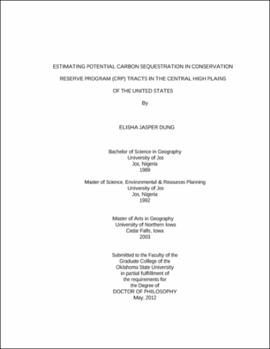| dc.contributor.advisor | Rao, Mahesh N. | |
| dc.contributor.author | Dung, Elisha Jasper | |
| dc.date.accessioned | 2013-11-26T08:24:05Z | |
| dc.date.available | 2013-11-26T08:24:05Z | |
| dc.date.issued | 2012-05 | |
| dc.identifier.uri | https://hdl.handle.net/11244/6768 | |
| dc.description.abstract | Scope and Method of Study: The main goal of this research is to examine long term trends in carbon sequestration in Conservation Reserve Program (CRP) tracts in the Central High Plains (CHP) region of the U. S. The second goal is to examine the amount of carbon sequestered in the CRP tracts before they were converted to CRP and compare the two. To achieve these goals, the following objectives are considered: To estimate the carbon sequestration potential in CRP in the CHP using an integrated model, CENTURY and GIS to evaluate rates of carbon sequestration and assess policy strategies and management practices for carbon sequestration in the study area; to compare the estimated amount of carbon sequestered in the study area before and after conversion to CRP; and to project future trends in carbon sequestration, and map the spatial and temporal distribution of carbon sequestration in the CHP. | |
| dc.description.abstract | Findings and Conclusions: CENTURY model estimated the total carbon sequestration for the pre-CRP period (1900-1984) as 11958.04 Kt and for the post-CRP period (1985-2010) as 39,682.8 kt; while estimates for same periods by DAYCENT are 21729.80Kt and 38,983.52 kt respectively. Between the pre-CRP and post-CRP periods, however, the CENTURY model indicates a 54% increase in carbon sequestration, while the DAYCENT model estimated only a 28% increase. The overestimation of carbon sequestration by the CENTURY model between the pre-CRP and post-CRP periods may be attributed to the fact that CENTURY runs on a monthly time step while DAYCENT runs on a daily time step. Similarly, the above ground carbon sequestered percentages are 9.7% and 14% for the CENTURY and DAYCENT models respectively; and 90.3% and 86% for below ground percentages for CENTURY and DAYCENT, respectively. The annual rates of carbon sequestration per unit area were also estimated for both models: CENTURY estimated 0.06 Kt per km2 per yr (pre-CRP) and 0.20 kt per km2 per yr (post-CRP); DAYCENT estimates were 0.11 Kt per km2 per yr (pre-CRP) and 0.19 kt per km2 per yr (post-CRP). In conclusion, estimates by the CENTURY and DAYCENT models indicate that the CRP program is effective in sequestering carbon in the CHP region. | |
| dc.format | application/pdf | |
| dc.language | en_US | |
| dc.rights | Copyright is held by the author who has granted the Oklahoma State University Library the non-exclusive right to share this material in its institutional repository. Contact Digital Library Services at lib-dls@okstate.edu or 405-744-9161 for the permission policy on the use, reproduction or distribution of this material. | |
| dc.title | Estimating potential carbon sequestration in Conservation Reserve Program (CRP) tracts in the Central High Plains of the United States | |
| dc.contributor.committeeMember | Lightfoot, Dale | |
| dc.contributor.committeeMember | Cordova, Carlos E. | |
| dc.contributor.committeeMember | Elliott, Norman | |
| dc.contributor.committeeMember | Davis, Craig A. | |
| osu.filename | Dung_okstate_0664D_11966.pdf | |
| osu.accesstype | Open Access | |
| dc.type.genre | Dissertation | |
| dc.type.material | Text | |
| dc.subject.keywords | carbon sequestration | |
| dc.subject.keywords | century model | |
| dc.subject.keywords | conservation reserve program | |
| dc.subject.keywords | daycent model | |
| dc.subject.keywords | global climate change | |
| dc.subject.keywords | land use | |
| thesis.degree.discipline | Geography | |
| thesis.degree.grantor | Oklahoma State University | |
